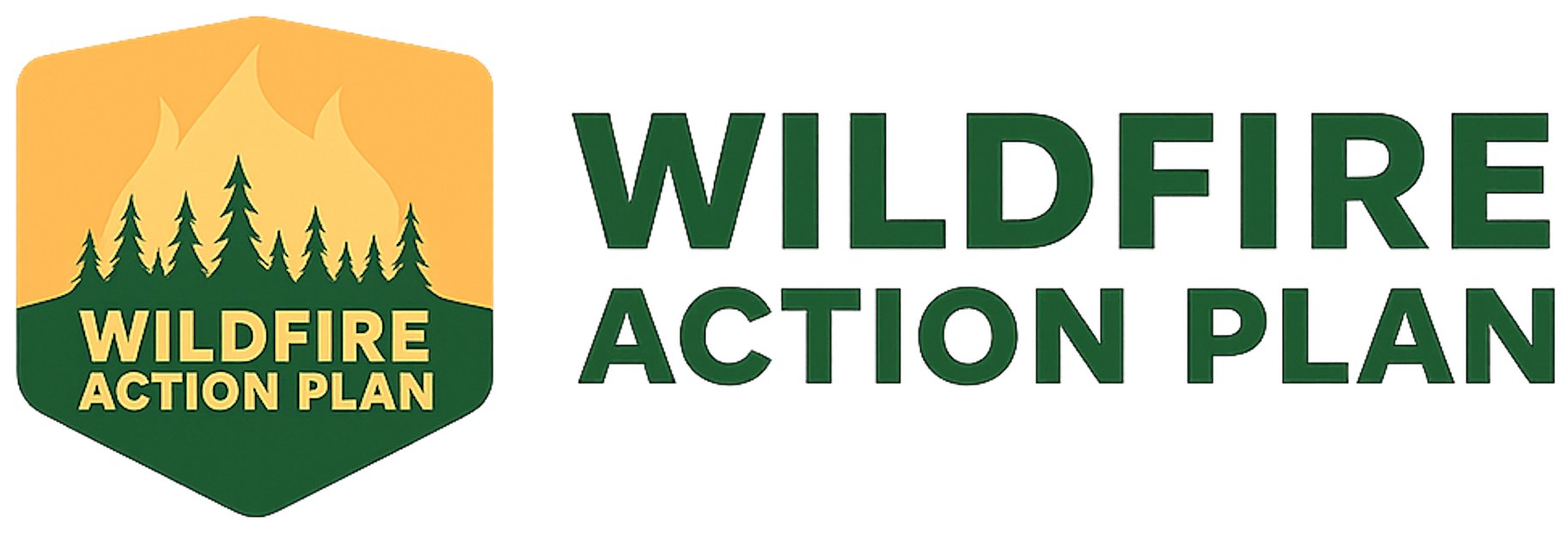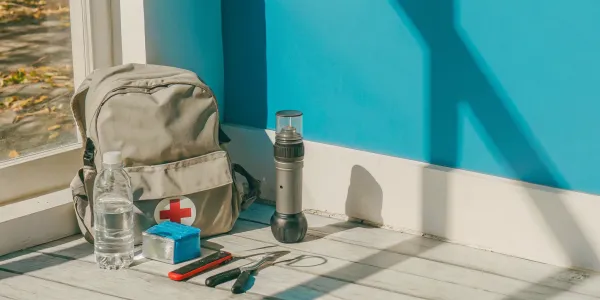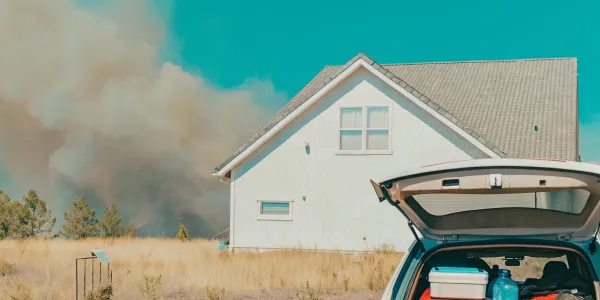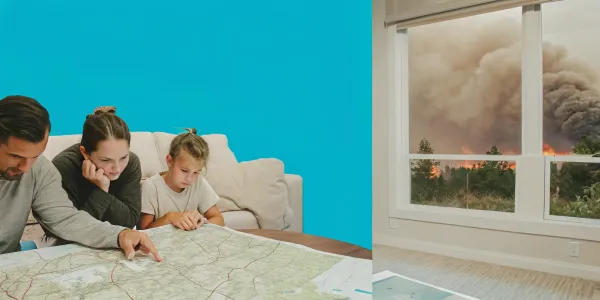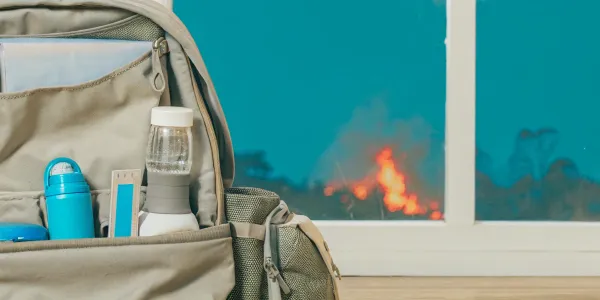How to Pack for a Wildfire Evacuation (Quickly and Safely)
Learn how to pack for a wildfire evacuation quickly with practical tips, essential go bag checklists, and steps to keep your family and pets safe.

After a wildfire, your focus shifts to recovery, and that process starts with your insurance company. But what happens if your policy documents, your home's deed, and your personal identification were all left behind? A chaotic evacuation can create a paperwork nightmare that lasts for months. A properly prepared "Go Bag" is more than just a survival kit; it's your first step toward a smoother recovery. By securing your critical documents alongside essential supplies, you protect both your family's safety and your financial future. This guide will show you how to pack for a wildfire evacuation quickly, ensuring you have the records you need to file claims and begin rebuilding your life without unnecessary delays.
Key Takeaways
- A Pre-Packed Go Bag is Non-Negotiable: Wildfires move faster than you can think. Having a dedicated emergency kit for each family member, ready to grab at a moment's notice, eliminates dangerous delays and ensures you can evacuate immediately.
- Think Beyond Canned Goods and Water: A truly effective Go Bag is personalized for your family's actual needs. It must include critical documents, a 7-day supply of all medications, specific supplies for pets and children, and backups for essentials like glasses or medical devices.
- A Go Bag is Only as Good as Your Plan: Your kit needs a strategy to work. Solidify your safety by mapping multiple escape routes, designating meeting points, and practicing your evacuation drill. Maintain your kit by checking it every six months to rotate supplies and update documents.
Why You Need a Wildfire Go Bag
When an evacuation order comes, your mind will be racing. The smell of smoke, the sound of sirens, and the urgency of the situation make it nearly impossible to think clearly. This is why a pre-packed wildfire Go Bag isn’t just a good idea—it’s an essential tool for your safety. A Go Bag is an emergency supply kit you assemble long before a fire threatens your home, containing everything you and your family need to survive for several days.
Having this kit ready means you can focus on the single most important task: getting to safety. Instead of scrambling to find birth certificates, medications, or a phone charger, you can grab your bag and go. Preparation is your best defense against the chaos of an emergency. It gives you a sense of control when everything feels uncontrollable. Building your Go Bag is a critical part of a larger strategy, and your personalized Wildfire Action Plan can help you identify exactly what you need to protect your family and property.
How Much Time Will You Really Have?
The honest answer is: less time than you think. Wildfires are unpredictable and can move incredibly fast, closing roads and cutting off power with little warning. While authorities issue evacuation warnings and orders, the window to act can be alarmingly short. Officials advise you to leave as soon as you are told to, or even sooner if your instincts tell you that you are in danger.
Don’t count on having hours to calmly sort through your belongings. In a fast-moving fire, you may only have minutes. Power outages can render garage doors and electric gates useless, adding another layer of complication. The time to prepare is now, not when you see smoke on the horizon.
Common Mistakes in Evacuation Packing
In the stress of an evacuation, it’s easy to forget crucial items. Many people who have been through a wildfire evacuation say they only realized what they should have packed after they were already safe at a shelter or a friend’s house. A common mistake is overlooking the small things that provide comfort and a sense of normalcy. This includes basic hygiene items, a book or a deck of cards to pass the time, and comfort items for children.
Another frequent error is failing to pack for your specific needs. Do you have pets? They need their own Go Bag with food and medication. Do you require prescription glasses or daily medication? Forgetting these can turn a stressful situation into a medical one. The biggest mistake of all is simply waiting too long to start. Packing under pressure guarantees you will forget something important.
What to Pack in Your Emergency Kit
When an evacuation order comes, you won’t have time to think. That’s why having a pre-packed emergency kit, often called a “Go Bag,” is one of the most important steps you can take to protect your family. This isn’t just a bag of supplies; it’s your lifeline, containing everything you need to survive for several days if you can’t return home. Thinking through what you need ahead of time allows you to act decisively when every second matters.
Your kit should be easily accessible, stored in a designated spot where you can grab it and leave without a second thought. The goal is to have a comprehensive collection of items that cover your family’s basic needs—from critical paperwork and survival gear to personal medical supplies and food. We’ll break down exactly what should go into your kit, category by category. Building your emergency supply kit is a tangible action that puts you back in control, ensuring you’re ready to face a wildfire evacuation with confidence.
Critical Documents and Records
In the chaos of an evacuation, the last thing you want to worry about is losing essential paperwork. Your Go Bag should contain copies of your most important documents, sealed in a waterproof and fire-resistant bag. This includes birth certificates, passports, social security cards, and driver’s licenses for everyone in your household. Don’t forget property-related documents like your home’s deed or rental agreement, and copies of your insurance policies. Having these on hand will be critical for recovery and filing claims later. Also, include a list of emergency contacts and phone numbers, as your phone may lose power. For an extra layer of security, create digital copies of everything and store them on a password-protected USB drive or a secure cloud service.
Essential Survival Supplies
Your kit needs the basics to keep you safe and informed, especially if power and cell service are down. Start with a battery-powered or hand-crank radio to receive emergency broadcasts and a powerful flashlight with extra batteries. N95 masks are essential for protecting your lungs from smoke and ash. A multi-tool can handle a variety of unexpected tasks, and a whistle can be used to signal for help. It’s also wise to pack a local map with your evacuation routes highlighted, in case GPS is unavailable. According to Fire Safe Marin, these simple tools are fundamental for staying safe and connected during an emergency.
Medical and Personal Items
Personal health and hygiene are crucial during a stressful evacuation. Pack a 7-day supply of all prescription medications for each family member, along with a list of dosages and the prescribing doctor’s information. Include a well-stocked first-aid kit with bandages, antiseptic wipes, pain relievers, and any specific medical supplies you might need, like an inhaler or EpiPen. Don’t forget spare glasses, contact lenses, and solution. Basic hygiene items are also important for comfort and health, so pack toothbrushes, toothpaste, soap, and other personal toiletries. If you have an infant, be sure to include diapers, wipes, and formula. Thinking through these personal needs ahead of time ensures no one’s health is compromised.
Food and Water Guidelines
You should plan to be self-sufficient for at least three days. The standard recommendation is to pack a 3-day supply of non-perishable food for each person in your household. Think high-energy, ready-to-eat items like protein bars, dried fruit, nuts, and canned goods. If you pack canned food, remember to include a manual can opener. For water, the guideline is one gallon per person, per day, for both drinking and sanitation. That means a family of four needs 12 gallons of water for a 3-day period. Store water in sturdy, sealed containers and choose food items that your family will actually eat to keep morale up.
Supplies for Family and Pets
An evacuation is stressful for everyone, including children and pets. For kids, pack a few small, comforting items like a favorite book, a small toy, or a game to help them feel secure. For your pets, prepare a dedicated Go Bag with a leash, collar with ID tags, and a sturdy carrier. Include a 3-day supply of their food and water, collapsible bowls, and any necessary medications. It’s also a great idea to have a current photo of you with your pet, which can help with identification if you become separated. Remember, many emergency shelters do not accept pets, so research pet-friendly hotels or boarding facilities along your evacuation route beforehand.
Irreplaceable Valuables
While your family’s safety is the top priority, some items are simply irreplaceable. Before an emergency, identify the sentimental valuables you would want to save. This could include family photos, small heirlooms, or children’s artwork. The key is to have these items gathered in one accessible place so you can grab them quickly. Digital assets are also valuable, so be sure your Go Bag includes a backup of your computer data on an external hard drive or USB stick. By deciding what’s most important to you ahead of time, you can avoid making difficult, rushed decisions during an evacuation and ensure your most cherished memories are protected.
How to Pack and Organize Your Kit
Once you know what to pack, the next step is organizing it for a fast getaway. A jumbled pile of supplies won't do you any good when every second counts. Strategic packing ensures you can grab what you need and leave immediately without fumbling through disorganized bags. It’s about making your exit smooth, safe, and efficient.
Choose the Right Container
When you’re forced to evacuate, you need to move quickly. The right container makes all the difference. A backpack is perfect for your most critical items—important papers, medications, and a change of clothes. For heavier supplies like bulk food and water, use a wheeled tub or a small chest. This lets you move a large volume of essentials without straining your back, ensuring you can get your emergency supply kit into the car without delay. The goal is grab-and-go, not stop-and-struggle.
Organize by Priority
The key to a manageable go-kit is to avoid overpacking. You can’t take everything, so focus on what truly matters. A great strategy is to have a separate, smaller kit for each person in your household. This distributes the weight and makes it easy for everyone to find their personal items, like specific medications or comfort items for children. By keeping things streamlined, you can make a go-kit that is practical and easy to handle in a high-stress situation.
Prepare a Vehicle Emergency Kit
An evacuation order can come when you’re at work or already on the road. That’s why keeping a dedicated emergency kit in your vehicle is non-negotiable. This kit acts as your first line of defense if you can’t get home. Stock it with essentials to get you through at least 72 hours. Your well-stocked emergency kit should include shelf-stable food and water, a flashlight with extra batteries, a small first-aid kit, and a flame-resistant blanket. This simple preparation ensures you’re ready for anything, no matter where you are.
Create Digital Backups
In a wildfire, physical documents can be lost forever. While you should pack original copies of critical papers, you also need a backup plan. The best way to safeguard important documents is to create digital copies. Scan your birth certificates, passports, social security cards, deeds, and insurance policies. Store these files on a password-protected USB drive in your go bag. For an extra layer of security, upload them to a secure cloud service. This ensures you can access your vital information from any device, anywhere, even if your physical copies are destroyed.
Your Evacuation Packing Timeline
When an evacuation order is issued, time is your most critical asset. Thinking in terms of a packing timeline helps you prioritize what matters most. The goal is to have your essential "Go Bag" packed and ready long before a fire threatens your home. This timeline isn't about starting from scratch; it's about a tiered approach to grabbing what you need based on how much notice you have. By preparing in advance, you can act decisively and safely when every second counts. Your Wildfire Action Plan should include a detailed inventory list to make this process even faster.
The 5-Minute "Must-Grab" List
This is your "get out now" scenario. If you have five minutes or less, there’s no time for decisions—only action. Your primary goal is to grab your pre-packed Go Bag and leave immediately. According to CAL FIRE, your emergency supply kit should be ready to go before a disaster happens. In this situation, you only have time for the absolute essentials that should be near the door or already in your car.
- Your pre-packed Go Bag(s) for every person and pet
- Keys (house and car)
- Phone and charger
- Wallet or purse (with ID and credit cards)
- Prescription medications you need daily
The 15-Minute Priority List
With a little more time, you can gather additional items that are important but couldn't be stored in your Go Bag. This is your chance to grab critical electronics, a few extra supplies, and items that provide comfort. Remember to keep your kits manageable; Fire Safe Marin advises ensuring your bag isn't too heavy in case you need to carry it on foot. This is also the time to put pets in their carriers and load everything into your vehicle.
- Everything from the 5-minute list
- Computers and external hard drives
- Additional water and non-perishable food
- Pet carriers, leashes, and extra pet food
- A change of clothes and sturdy shoes for everyone
- Pillows and blankets
The 30-Minute Complete Checklist
An evacuation warning gives you a crucial window to prepare for a potential order. With 30 minutes, you can be more thorough. This is your opportunity to grab sentimental items and perform last-minute tasks to give your home a better chance of survival. Once your car is packed, don't wait. CAL FIRE recommends keeping your Go Bag in your vehicle so you can leave as soon as possible.
- Everything from the 15-minute list
- Irreplaceable valuables (photo albums, family heirlooms)
- Important papers if not already in your Go Bag
- Evacuation route map
- Quick home prep: Close all windows and doors, shut off gas, and leave lights on so firefighters can see your home through smoke.
Plan for Special Needs
Every household is unique, and your evacuation plan must reflect that. Consider the specific needs of children, elderly family members, individuals with medical conditions, and pets. Each person should have their own personalized kit. For infants, this means packing formula, diapers, and comfort items. For older adults, include backup batteries for medical devices, a list of doctors, and copies of prescriptions. Don't forget your pets—have carriers, food, water, and ID tags ready. Planning for these specific needs ahead of time ensures no one and nothing important is left behind in a stressful moment.
Create Your Family and Pet Evacuation Plan
A wildfire evacuation plan is more than just a checklist; it’s a coordinated strategy to get every member of your family—including the furry ones—to safety. When stress is high and time is short, having a clear plan for communication, medical needs, and pet care removes the guesswork. It ensures that you can focus on what matters most: getting everyone out safely.
Pack for Your Children
Every person in your home, including each child, should have their own go-kit. This helps distribute the load and gives older kids a sense of responsibility. Pack their bags with comfortable clothes, sturdy shoes, a favorite toy or book for comfort, and a flashlight. It’s also smart to include a card with family contact information and your designated meeting spots. Involving your children in packing their own bags can help them feel more prepared and less anxious about the process. Remember to have an extra kit on hand for any visitors who might be staying with you.
Prepare Your Pet's Go Bag
Your pets are part of the family, and they need an evacuation plan, too. Their go bag should include a sturdy carrier for each animal, leashes, and at least a three-day supply of food and water. Don't forget bowls, medications, and copies of their vaccination records. Most importantly, you need to plan where your pets will go. Many emergency shelters cannot accept animals, so identify pet-friendly hotels or boarding facilities outside your immediate area ahead of time. Have a list of these locations ready in your kit so you aren't scrambling to find one during an evacuation.
Manage Medical Requirements
Gathering medical necessities is a critical step that can’t be left to the last minute. Your family’s go bags should contain a supply of any prescription medications. Talk to your doctor about getting an extra few days' supply specifically for your emergency kit, and set a calendar reminder to rotate it yearly so it doesn’t expire. Also include copies of your prescriptions, a first-aid kit, and any other essential health items like glasses, contact lenses, or hearing aids with extra batteries. Having these items packed and ready means you can manage your family’s health needs without adding stress during an emergency.
Set Up a Communication Plan
When a wildfire strikes, local phone lines can quickly become overwhelmed. Your family needs a clear communication plan to stay connected. Designate a single out-of-state contact person for everyone to call or text. It’s often easier to reach someone far away when local circuits are busy. Make sure everyone has this person’s number saved in their phone and written on a physical card in their wallet. This plan, along with your evacuation routes and meeting points, is a core part of a complete Wildfire Action Plan that keeps your family coordinated and safe.
How to Evacuate Safely
Packing your go bag is a huge step, but your plan isn't complete until you know exactly how you’ll leave when the time comes. During a wildfire, roads can close in an instant and cell service can become unreliable. Thinking through your evacuation logistics now ensures you can act decisively under pressure, keeping yourself and your family safe when every second counts. A clear, practiced plan removes the guesswork from a chaotic situation.
Plan Multiple Escape Routes
Your primary route out of the neighborhood might be the one you use every day, but you can’t count on it being open during a wildfire. Your first step is to identify at least two different escape routes from your home. Use a physical map or an offline digital map to trace these paths. Consider different directions—north, south, east, and west—if possible. Talk to neighbors about local roads you may not be familiar with. Having these alternatives ready is crucial, as one path could easily become blocked by fire or traffic. A well-thought-out evacuation plan is one of the most important tools you have.
Arrange Backup Transportation
A car is useless in an evacuation if it doesn’t have gas or won’t start. Make it a habit to keep your vehicle’s gas tank at least half full at all times. This simple rule prevents a last-minute panic stop for fuel when you need to be leaving. You should also think about a backup plan. What if your primary car is in the shop or blocked in the garage? Coordinate with a trusted neighbor to see if you can ride with them in an emergency, or identify which family member’s car will be the designated evacuation vehicle.
Designate Emergency Meeting Points
In the confusion of an evacuation, your family could get separated. To handle this, designate two specific meeting points in your family’s plan. The first should be a spot nearby but safely away from your home, like a specific tree at the end of the block or a neighbor’s front yard. The second should be a location outside your immediate area, such as a library, community center, or relative’s house in a nearby town. Make sure everyone in your family knows these locations by heart. Having this written down in your Wildfire Action Plan ensures everyone is on the same page.
Communicate While on the Move
Don’t assume your cell phone will work perfectly during a wildfire. High call volumes can jam networks, and nearby cell towers could lose power. Keep a small, laminated card in your wallet and in your go bag with key contact information and your designated meeting places. It’s also a good idea to establish an out-of-state contact person. It's often easier to make a long-distance call than a local one during a regional emergency. This person can act as a central point of contact, relaying messages between family members who can’t reach each other directly.
How to Maintain Your Go Bag
Packing a Go Bag is a critical first step, but it’s not a one-and-done task. An emergency kit is a living resource that needs regular attention to be effective when you need it most. Supplies expire, batteries die, and your family’s needs change over time. Maintaining your kit ensures that when an evacuation order comes, you can grab your bag with confidence, knowing everything inside is ready to go. Think of it as simple, scheduled maintenance for your family’s safety. A few minutes of review every six months can make all the difference in a crisis.
Check Your Kit Regularly
Set a recurring reminder on your calendar—every six months is a good rhythm—to do a full review of your Go Bag contents. During this check, physically open every pocket and inspect each item. Test any battery-powered devices like flashlights and radios, and replace the batteries even if they still work. Check the fit of spare clothing, especially for children who grow quickly. Make sure sealed items in your first-aid kit are still intact and that nothing has been damaged or crushed. This is also the perfect time to review your complete wildfire action plan and update it with any changes to your household, such as new medications or contact information.
Rotate Supplies Seasonally
Many essential items in your Go Bag have a shelf life. Food, water, medications, and even sanitation wipes expire. When you do your six-month check, rotate these supplies. Move the items nearing their expiration date from your kit into your home pantry to be used, and replace them with fresh supplies. This prevents waste and guarantees your emergency food is safe to eat. Also, consider the seasons. The lightweight shirt you packed in July won’t be enough for a November evacuation. Swap out a few articles of clothing to match the potential weather, ensuring you have appropriate layers, socks, and outerwear.
Practice Your Evacuation Drill
A well-packed bag and a paper plan are only useful if your family knows how to use them under pressure. Practicing your evacuation drill at least twice a year turns a stressful concept into a familiar routine. A drill doesn't have to be frantic; simply walk through the steps. Have each family member locate their Go Bag and any personal items they are responsible for. Practice your "5-minute grab list" for irreplaceable items. Load everything into your vehicle and drive one of your planned evacuation routes. This simple exercise helps identify weaknesses in your plan and builds the muscle memory needed to act quickly and calmly during a real emergency.
Keep Your Documents Updated
Your Go Bag should contain copies of your most critical documents, but these records often change. During your regular kit review, make sure your document file is current. This includes updating your insurance policies after renewal, adding recent bank statements, and ensuring passports or IDs haven't expired. If you've refinanced your home or bought a new car, add the new title and registration copies. Store physical copies in a sealed, waterproof bag. For added security, maintain a digital backup on an encrypted USB drive stored in your kit and consider a secure cloud-based service as a third layer of protection.
Related Articles
- Wildfire Car Emergency Kit: The Ultimate Checklist
- 5-Minute Evacuation Checklist: What to Grab Now
- The Essential 14-Day Emergency Kit List [Checklist]
Frequently Asked Questions
I'm worried about the cost. How much should I expect to spend on building a Go Bag? You don’t need to spend a fortune to be prepared. Many of the essential items, like copies of documents, spare clothes, and non-perishable food from your pantry, are things you already have. Start by gathering what’s on hand, and then make a list of the few items you need to buy, like a hand-crank radio or a good first-aid kit. The goal is to be safe and self-sufficient, not to buy expensive gear. A well-thought-out kit is far more valuable than a costly one.
Where is the best place to keep my finished Go Bag? The best spot is somewhere you can get to quickly on your way out the door. For many people, that’s a front hall closet, the mudroom, or in the garage right next to the door leading into the house. The key is to avoid burying it in the back of a closet or deep in the basement. You should also keep a smaller version of your kit in your car, since an evacuation order could come when you’re away from home.
How can I pack a Go Bag with my kids without making them anxious about wildfires? This is a great question, and it’s all about framing. You can present the task as creating a "family adventure kit" for an unexpected trip. Let them take charge of packing their own small bag with their favorite comfort items, a book, and a special snack. By focusing on it as a way to stay safe and be prepared for anything, you empower them instead of introducing fear. It becomes a positive action you take together as a family.
Is having a Go Bag the only thing I need to do to prepare for an evacuation? Your Go Bag is a critical piece of the puzzle, but it’s one part of a larger safety strategy. A complete plan also includes knowing multiple escape routes from your neighborhood, having a designated meeting spot for your family, and establishing a communication plan in case you get separated. Think of the Go Bag as the tool that enables you to act on your plan without hesitation.
Why do I need to check my kit every six months? Isn't once a year enough? Checking your kit twice a year makes sure it’s always ready for the current season. The lightweight jacket you packed in the spring won’t be enough for a fall evacuation. This schedule also helps you catch food, water, and medications before they expire, and it’s a perfect time to swap out batteries in your flashlight and radio. A quick, 20-minute check every six months keeps your kit reliable and ready to go when you need it most.
